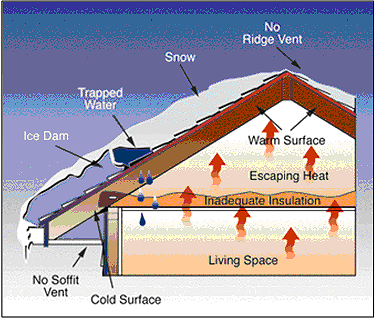
Ice dams are most common in northern climates. They occur when heavy snow buildup melts during the day and then refreezes when temperatures drop overnight.
After several days of melting-freezing cycles, it's common for the melted water and ice to work up under the shingles until water enters the attic and eventually does damage to the ceilings, wall and contents. In cases where the ice dam goes unnoticed for an extended period of time, it can do significant damage to the building and its contents.
There's no way to guarantee an ice dam won't damage your home, but you can take steps to cut the chances of an ice dam forming in the first place:
- If you haven't already, thoroughly clean all leaves, sticks and other debris from your home's gutters and down spouts. This allows melting roof snow to flow into gutters and through down spouts.
- Make every effort to keep snow on your roof to a minimum. Long-handled devices on the market called "roof rakes" let you stand on the ground and pull the snow off the roof. Keeping heavy snow loads off your roof reduces the chances for both ice dam formation and roof failure due to the weight.
- All winter long, keep gutters and down spouts clear of snow and icicles.
- Evaluate the insulation and ventilation in your attic. Most experts agree the R-value of attic insulation should be at least R-30 (R-38 is preferable in northern climates). In addition, good airflow from under the eaves or soffit area along the underside of the roof and out through the roof vents is essential. The insulation prevents heat loss from the interior of the home. The venting allows the attic air to stay cold enough to prevent or minimize the freeze/thaw cycle on the roof. Consult a reputable roofing and/or insulation contractor about these improvements.
